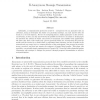Free Online Productivity Tools
i2Speak
i2Symbol
i2OCR
iTex2Img
iWeb2Print
iWeb2Shot
i2Type
iPdf2Split
iPdf2Merge
i2Bopomofo
i2Arabic
i2Style
i2Image
i2PDF
iLatex2Rtf
Sci2ools
CCS
2003
ACM
2003
ACM
k-anonymous message transmission
Informally, a communication protocol is sender k - anonymous if it can guarantee that an adversary, trying to determine the sender of a particular message, can only narrow down its search to a set of k suspects. Receiver k-anonymity places a similar guarantee on the receiver: an adversary, at best, can only narrow down the possible receivers to a set of size k. In this paper we introduce the notions of sender and receiver k-anonymity and consider their applications. We show that there exist simple and efficient protocols which are k-anonymous for both the sender and the receiver in a model where a polynomial time adversary can see all traffic in the network and can control up to a constant fraction of the participants. Our protocol is provably secure, practical, and does not require the existence of trusted third parties. This paper also provides a conceptually simple augmentation to Chaum’s DC-Nets that adds robustness against adversaries who attempt to disrupt the protocol through...
| Added | 06 Jul 2010 |
| Updated | 06 Jul 2010 |
| Type | Conference |
| Year | 2003 |
| Where | CCS |
| Authors | Luis von Ahn, Andrew Bortz, Nicholas J. Hopper |
Comments (0)

